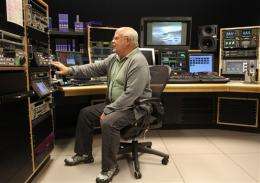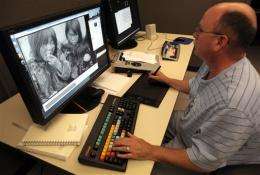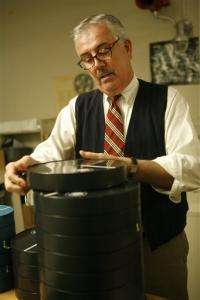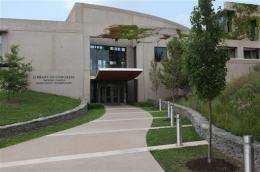'Essential' film copyright protection turns 100

(AP)—In the crisp 39-degree Fahrenheit (4-degree Celsius) air of a converted bunker in rural Virginia lies the U.S.'s greatest collection of early film.
Stacked in metal tins on shelves in 124 concrete vaults that stretch almost eight-feet (2.5-meters) high, movies that wowed audiences decades ago are meticulously stored so that one day, they may play again.
The vaults at the Library of Congress' Packard Campus for Audio-Visual Conservation in Culpeper, Virginia, represent decades of work by copyright officials to not only protect the rights of filmmakers, but also preserve their movies for future generations.
The collection is in many ways the culmination of work that began 100 years ago Friday, when U.S.-made movies earned their own copyright designation and transformed from a fledgling industry into a global economic and cultural juggernaut.
"Copyright was very essential from the very beginning of the industry," said Patrick Loughney, chief of the Packard campus, a former Federal Reserve bunker 90 minutes west of Washington, D.C., that has been converted into a state-of-the-art archive. It is a dual safe-haven, intended to protect both the film's creators and, in the process, establish a collection that outlasts a film's box-office haul.
"It's basically been a Noah's Ark effort to save the creative history of the United States," he said.

Congress carved out a film copyright designation on Aug. 24, 1912, and within weeks, filmmakers were registering their dramas, documentaries and comedies. The first was "Black Sheep's Wool," a melodrama about the troubles of European nobility who came to North America.
It, like many films of its age, is lost. But the Packard Campus does have the only known copy of the fourth film registered, a 1912 version of "The Charge of the Light Brigade" created by Thomas Edison's film company.
Fragments of another of the first five films registered remain in another archive run by New York's Museum of Modern Art, he said, but the rest are currently considered lost.
Although more than 5,600 earlier films had received copyright protection, Loughney and others say creating a film category reflected its growing influence and the desire to see it protected.
"It certainly adds legitimacy to a medium if it's recognized and has its own category," said Michael O'Leary, a senior vice president of global affairs for the Motion Picture Association of America.

For early filmmakers, "It gave them a little bit of a protection, a little bit of security. They were probably on a little more tenuous ground than we are today," he said.
Early films faced a familiar concern for modern studios—piracy.
"America was a hotbed for that activity, certainly for film," Loughney said.
Early filmmakers often resorted to putting their logos on the backdrops of their sets to discourage piracy, Loughney said. He's seen prints where an infringing movie house had actually scratched out the logos from each frame.

Today, movie pirates sell cheap DVDs of films that are still in theaters and in some cases, hacking studio servers to get access to new releases. Federal authorities have prosecuted or shut down websites suspected of copyright infringement.
For Loughney, the priority is ensuring that films and other works housed at the Packard Campus remain available for future generations to enjoy. That is why the staff maintains copies—and the equipment to play them—of bygone film technologies such as tapes and reels.
Eventually many of the works may be digitized, but the facility houses the only known copies of many works. "Our mission is to keep it forever," Loughney said. "When we say forever, we have to mean it."
Only a fraction of the works produced between 1912 and 1930 survive, in part because they were produced on nitrate film, which is so flammable, the Library of Congress wouldn't accept copies of the films until around 1940.
Instead, a copyright agent would review a reel of the film when it was brought to Washington, but it would not be kept.

The nitrate vaults at Packard are just one element of its preservation efforts. Today, copies of all registered films are filed with the Copyright Office and kept for posterity and in case a lawsuit is filed. Films of all kinds—from blockbusters to B-movies to porn films—flow into the facility in formats ranging from traditional film reels to special hard drives. It costs $35 to register a movie online and $65 on paper, no matter what the film's budget.
Packard also preserves copyrighted music and other recordings, and newer creations such as video games.
"Copyright is more important than ever," Loughney said. "It has a practical function. The physical depositing or registering of material creates a national archive that can live on for future generations," he said.
Indeed, many of the early films registered under the movie designation offer a peek into audience preferences, with fewer superheroes but not that dissimilar from today. They included dramas focusing on nobility, adventure and war stories, and comedies.
"I think the average American never thinks of copyright," he said. "It has served an important function in the past and should serve an important function in the future."
___
Packard Campus for Audio-Visual Conservation: www.loc.gov/avconservation/packard/
___
Anthony McCartney can be reached at twitter.com/mccartneyAP
Copyright 2012 The Associated Press. All rights reserved. This material may not be published, broadcast, rewritten or redistributed.



















